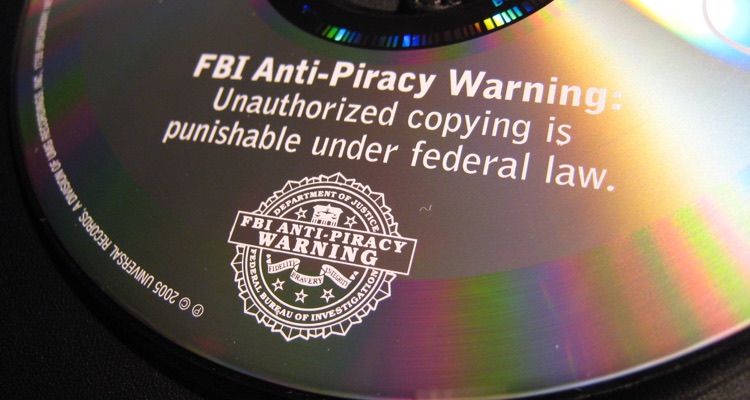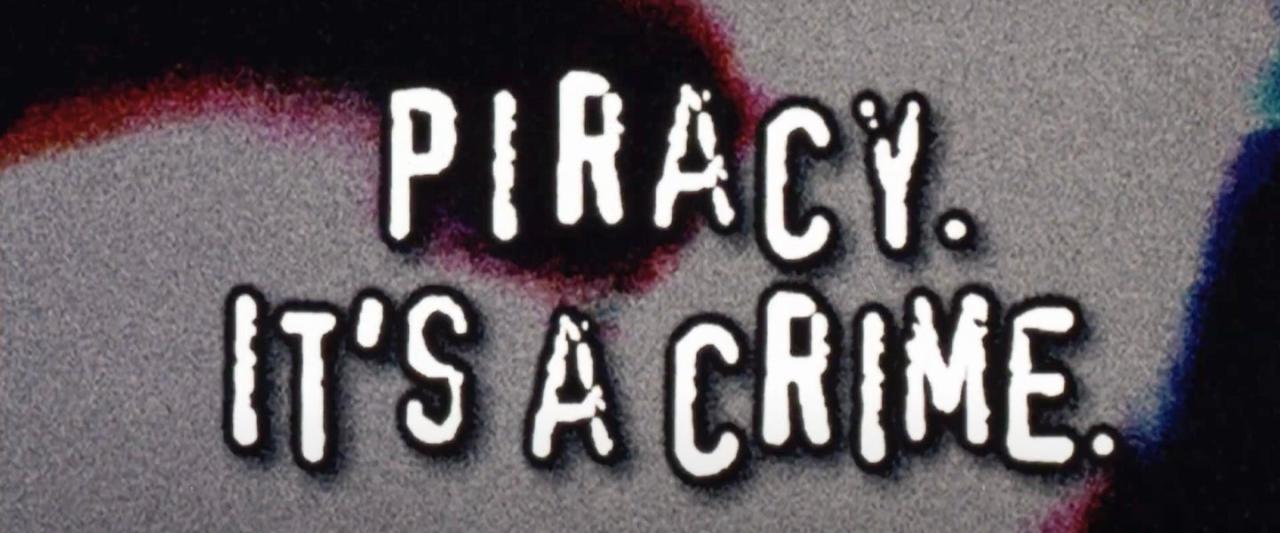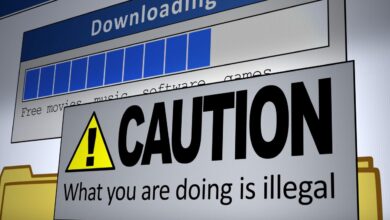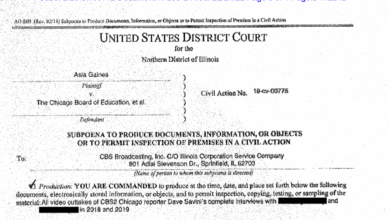New Attack on DVD Piracy Goes Too Far
New attack on DVD piracy goes too far. This new crackdown on DVD piracy is raising eyebrows, and for good reason. We’re diving deep into the history of piracy, examining the evolving methods, and exploring the potential negative impacts on consumers and legitimate businesses. The question remains: is this the right approach, or is it taking things a bit too far?
The article will delve into the specifics of this “new attack,” contrasting it with previous strategies. We’ll analyze the motivations behind this approach, alongside its potential pitfalls. Ultimately, the goal is to understand the full picture and explore alternative, more balanced solutions to tackle DVD piracy.
Overview of DVD Piracy
DVD piracy, a persistent challenge to the entertainment industry, has evolved significantly since the format’s introduction. From simple physical copying to sophisticated digital distribution, the methods and impact of piracy have adapted alongside technological advancements. This evolution reflects a complex interplay of economic pressures, technological capabilities, and legal frameworks.The history of DVD piracy is intertwined with the rise of the DVD format itself.
The availability of affordable, high-quality DVD players and recorders made the ease of copying and distributing films a major concern for studios and distributors. This was further amplified by the lack of robust anti-piracy measures in the early days.
Early Years of DVD Piracy (Early 2000s)
The initial years of DVD piracy focused primarily on physical replication. Home-based duplication centers, often operating in unregulated environments, were prolific in creating illicit copies. This was made easier by the relative simplicity of DVD duplication technology compared to other formats. The widespread availability of DVD-R/RW drives played a crucial role in facilitating this process. The impact on the legitimate DVD market was substantial, leading to revenue losses and a need for stronger anti-piracy measures.
Evolving Methods and Technologies (Late 2000s)
As the internet became more pervasive, methods of DVD piracy shifted towards online distribution. Torrenting platforms and file-sharing networks emerged as key tools for disseminating pirated copies. These platforms allowed for rapid distribution and accessibility of movies, further increasing the ease of piracy. The use of encryption and anti-copying measures became increasingly important in response to this shift.
The Current Landscape (Present)
The current landscape of DVD piracy is characterized by a blend of physical and digital methods, though online distribution remains dominant. While physical duplication still occurs, particularly in certain regions with limited access to legitimate content, the internet continues to be the primary avenue for pirated content. The emergence of streaming services and the rise of high-speed internet have changed the piracy landscape, with pirated copies often being streamed or downloaded to be viewed later.
The impact on revenue and the creative industry continues to be a significant concern. The legal battles and enforcement efforts are ongoing, reflecting the continuous challenge of combating piracy in a rapidly evolving digital environment.
Comparison of DVD Piracy Methods Across Decades
| Decade | Primary Method | Key Technologies | Impact |
|---|---|---|---|
| Early 2000s | Physical duplication | DVD-R/RW drives, home-based duplication centers | Significant revenue loss for studios; limited online presence |
| Late 2000s | Online distribution (torrenting) | File-sharing networks, peer-to-peer networks | Increased accessibility and ease of distribution; significant impact on revenue and legal battles |
| Present | Online distribution (streaming/downloads) | High-speed internet, streaming platforms, cloud storage | Continuing impact on revenue, though the method of delivery has evolved; enforcement and legal battles continue |
The New Attack on DVD Piracy

The fight against DVD piracy has taken a significant turn. Traditional methods, such as lawsuits and copyright claims, are being supplemented by a more aggressive, multifaceted approach. This new strategy, while potentially effective, also raises concerns about its impact on consumers and the balance between intellectual property rights and fair use. This post delves into the specifics of this evolving approach.The new strategy involves a combination of proactive measures aimed at disrupting piracy networks and a more sophisticated approach to deterring future piracy.
This approach is not simply reactive but attempts to anticipate and prevent future illegal activities. It targets not just the distributors but also the infrastructure and processes that support piracy.
Specific Actions of the New Attack
This new attack on DVD piracy employs several tactics. These include:
- Enhanced Digital Rights Management (DRM) technologies: Advanced DRM systems are being integrated into DVDs, making it more difficult to copy or distribute the content without authorization. This involves incorporating more robust encryption and authentication methods, making illegal copies less viable. For example, Blu-ray discs often have more sophisticated DRM compared to older DVD formats.
- Aggressive legal action against online piracy marketplaces: This involves pursuing legal action against websites and online forums that facilitate the distribution of pirated DVDs. This strategy goes beyond individual users, targeting the platforms enabling the illegal trade. This includes takedown requests and lawsuits against entire platforms, as well as their operators.
- Partnerships with ISPs: Internet service providers (ISPs) are increasingly collaborating with content owners to block access to pirated content. This proactive approach can help curb the spread of illegal downloads and streaming. This could involve IP blocking or filtering of specific torrent websites.
- Cybersecurity Measures: Enhanced cybersecurity measures are deployed to detect and prevent unauthorized access to content and distribution channels. This includes monitoring and blocking suspicious IP addresses or domains. This is not limited to only targeting individuals but extends to the entire piracy infrastructure.
Motivations Behind the New Approach
The motivations behind this new approach are multifaceted. They include:
- Increased profitability and revenue protection: Content creators and distributors seek to protect their investments and maximize returns by preventing the loss of revenue from piracy. This is a major driving force behind the increased investment in new strategies.
- Addressing the scale of the problem: The sheer volume of pirated DVDs circulating globally necessitates a comprehensive and multifaceted approach to tackle the problem effectively. This new approach recognizes the widespread nature of the issue and the need for a more substantial response.
- Shifting consumer behavior: The emergence of digital alternatives like streaming services has led to a changing landscape in media consumption. The new attack aims to adjust to these shifts and deter individuals from pirating physical media, rather than simply responding to existing piracy.
Comparison with Previous Strategies
Previous strategies often focused on reactive measures, such as lawsuits against individuals or small-scale distributors. The new approach is significantly more proactive and targets the infrastructure and networks enabling piracy. It’s a shift from simply reacting to the problem to preventing it.
Pros and Cons of the New Attack
| Pros | Cons |
|---|---|
| Increased effectiveness in disrupting piracy networks. Examples include successful takedowns of major torrent sites and the decrease in piracy of popular films on specific platforms. | Potential for overreach and infringement on freedom of speech. Blocking access to certain websites or content could restrict access to information and expression. This could lead to controversy and potential legal challenges. |
| Enhanced protection of intellectual property rights. This leads to higher revenue streams and more secure financial returns for content creators. This protection also impacts the future development of the industry. | High costs associated with implementing new technologies. Developing and deploying advanced DRM, cybersecurity measures, and legal action against online marketplaces can be expensive, requiring substantial financial investment. |
| Deterrent effect on future piracy attempts. The new approach discourages potential pirates by increasing the risk of detection and punishment. | Potential for negative impact on consumers. Increased DRM and restricted access could limit consumer choices and freedom to acquire content in certain ways. |
The “Too Far” Aspect
The recent crackdown on DVD piracy, while seemingly a necessary step to protect intellectual property, raises concerns about potential overreach. The new measures have a significant potential for unintended consequences, affecting not only pirates but also legitimate users and potentially harming the creative industries in the long run. A balanced approach is crucial to ensure that the fight against piracy doesn’t stifle the very freedoms it intends to protect.The new attack on DVD piracy, while seemingly targeted at illegal activity, risks creating a climate of fear and suspicion that extends beyond the intended perpetrators.
This broader impact could lead to increased surveillance, censorship, and restrictions on personal freedoms, a critical concern in a society that values the right to access information and entertainment. This concern is particularly relevant in a world where technology empowers individuals to share and consume content in innovative ways.
Potential Negative Consequences for Legitimate Users
The new approach to combatting DVD piracy could have unintended negative impacts on legitimate users. For example, stricter enforcement might lead to higher prices for legitimate DVDs due to increased production costs and enforcement measures. This could disproportionately affect low-income individuals who rely on affordable entertainment options.Furthermore, restrictions on sharing or copying DVDs for personal use, even if not strictly illegal, could limit educational and personal use cases.
Students and researchers, for instance, may face challenges in accessing necessary materials for their work. This could also negatively impact the availability of educational materials and research resources, limiting access to knowledge and hindering progress in various fields.
This new crackdown on DVD piracy seems a bit extreme. It’s interesting to consider how music sales are holding strong despite rampant digital piracy, as shown in this insightful article on music sales strong despite digital piracy. Maybe there’s a better way to approach copyright infringement than just hitting hard on physical media; maybe the focus should be more on the digital distribution side.
The DVD piracy issue still needs a balanced solution.
Potential for Unintended Negative Impacts on the Creative Industries
A disproportionately harsh response to DVD piracy could damage the creative industries in the long run. If the public perceives the anti-piracy measures as overly aggressive or intrusive, it could deter consumers from purchasing legitimate products. This reduced demand could, in turn, impact the livelihoods of artists, producers, and distributors. The focus should be on promoting legitimate channels of access and fostering a healthy ecosystem where both creators and consumers can thrive.
Ethical Concerns Related to the New Approach
The new anti-piracy measures raise several ethical concerns. The question of balancing the rights of copyright holders with the right of access to information and entertainment becomes paramount. An overly aggressive approach could potentially violate fundamental freedoms, such as freedom of expression and access to information. A more nuanced approach that considers these ethical dimensions is essential.
Examples of Similar Situations Where Overzealous Anti-piracy Measures Caused Controversy
Numerous instances in the past highlight the potential for unintended consequences when anti-piracy measures are overly aggressive. The “Napster” case, for example, demonstrates how restrictive measures can create resistance and potentially damage the industry’s reputation. Similarly, the “Digital Millennium Copyright Act” (DMCA) has been debated for its potential impact on freedom of expression and access to information. These examples underscore the importance of carefully considering the broader implications of anti-piracy measures and their potential effects on society as a whole.
Potential Impact on Consumers
The escalating war against DVD piracy has reached a new, potentially disruptive phase. This new approach, while aiming to curb illegal distribution, raises significant concerns about its impact on consumers, from their purchasing habits to the very availability of content. Understanding these repercussions is crucial to evaluating the long-term consequences of this intensified crackdown.
Consumer Behavior Changes
This new offensive against DVD piracy could prompt several shifts in consumer behavior. Consumers might be deterred from purchasing pirated DVDs due to the increased risk of legal repercussions. Conversely, some might switch to alternative, potentially less secure, methods of acquiring content. This could include using peer-to-peer networks, online file-sharing services, or seeking out content through less regulated platforms.
The availability of legitimate content may also influence the consumer’s decision-making process.
Impact on Content Availability
The crackdown on DVD piracy could potentially impact the availability of certain content. If legitimate distributors are hesitant to release content due to the increased risk of piracy, or if their distribution channels are negatively affected, a reduction in the variety of titles might occur. This could especially affect older films, documentaries, or niche genres, as these are often less profitable for distributors.
Financial Impacts on Consumers, New attack on dvd piracy goes too far
The consequences on consumer finances are multifaceted. Increased legal action against piracy might lead to higher prices for legitimately acquired DVDs. Conversely, consumers could potentially save money if they shift to legitimate streaming services. The overall effect will likely depend on the effectiveness of the new anti-piracy measures, and the subsequent actions of content providers.
Consumer Reaction Scenarios
The response to this new approach will likely vary across different demographics. A table outlining potential scenarios illustrates this.
That new crackdown on DVD piracy seems a bit extreme. While companies like Comcast are successfully expanding their high-speed internet offerings, as detailed in this article about despite DSL pressure Comcast touts high speed customer gains , maybe there’s a better way to discourage illegal copying than these heavy-handed measures. Ultimately, the fight against DVD piracy feels a bit overblown, considering the real problems facing consumers today.
| Demographic | Potential Reaction | Explanation |
|---|---|---|
| Young Adults (18-25) | Increased reliance on illegal streaming | This group often prioritizes affordability and readily accessible content. If legitimate avenues become more expensive or less convenient, they may be more inclined to resort to illegal methods. |
| Middle-Aged Adults (25-55) | Potential shift to streaming services or digital rentals | This group is more likely to weigh the convenience and legality of different options. Higher DVD prices or increased risks associated with illegal downloads may lead them to opt for safer alternatives. |
| Seniors (55+) | Potential resistance to change; increased reliance on traditional retail options | This demographic may be less comfortable with new technologies and might prefer traditional methods. If these methods become less available, this could lead to frustration and a reduction in access to certain content. |
| Low-income households | Increased reliance on free, potentially illegal options | Affordability is a primary concern for this group. Higher prices for legitimately acquired DVDs could lead them to prioritize free, albeit potentially illegal, options. |
| High-income households | Continued reliance on legitimate options, but potentially with an increase in digital rentals | This demographic is often more comfortable with new technologies. They may continue to support legitimate distributors, but could potentially opt for digital rentals or streaming services if they perceive them as more convenient or secure. |
Alternative Solutions
Combating DVD piracy requires a multifaceted approach that goes beyond aggressive legal action. Focusing solely on punitive measures often overlooks the underlying reasons for piracy and can have unintended consequences. A balanced strategy that considers the needs of both consumers and rights holders is crucial for long-term success. Instead of simply suppressing the problem, we need to find ways to make legitimate content more accessible and attractive.
Alternative Solutions to DVD Piracy
Addressing DVD piracy requires a multifaceted approach. Focusing solely on punitive measures often misses the mark. A balanced strategy considering the needs of both consumers and rights holders is essential. Alternative solutions aim to make legitimate content more attractive, thus reducing the appeal of pirated copies.
User-Friendly and Accessible Digital Distribution
Digital distribution platforms, offering a wider array of content and user-friendly experiences, can significantly reduce the incentive for piracy. Streamlined download options, high-quality streaming, and affordable subscription services are key. Providing convenient and legally accessible options for consumers to obtain content is vital.
Examples of Successful Anti-Piracy Strategies in Other Industries
The music industry has seen success through the introduction of digital music platforms. Sites like iTunes and Spotify offered a more convenient and often cheaper alternative to physical CDs, reducing the appeal of illegal downloads. The gaming industry has also implemented strategies such as digital distribution and subscription services, making it easier and more affordable for players to access games legally.
These examples demonstrate that focusing on the user experience can be more effective than relying solely on punitive measures.
Mitigating Negative Impacts on Consumers
While combating piracy is important, it’s equally crucial to mitigate negative impacts on consumers. High prices for legitimate products can drive consumers towards illegal options. A balanced approach involves making legitimate content more affordable and accessible. For example, introducing lower-priced subscription models or offering bundles can be effective in reducing piracy.
Comparing Anti-Piracy Strategies
| Strategy | Effectiveness | User Impact |
|---|---|---|
| Aggressive Legal Action | Potentially effective in deterring large-scale piracy operations but may not address individual consumers’ needs. | Can lead to negative public perception and distrust of industry. |
| Digital Distribution Platforms | High effectiveness in reducing piracy by providing user-friendly, convenient, and often more affordable alternatives. | Positive user impact by offering better access to content and more options. |
| Content Accessibility and Affordability | High effectiveness in addressing the underlying reasons for piracy. | Positive user impact by making content accessible and reducing the perceived need for pirated copies. |
| International Collaboration | Potentially effective in disrupting large-scale piracy networks. | May not always have a direct user impact. |
Legal and Ethical Implications
The new attack on DVD piracy raises significant legal and ethical concerns, extending beyond the simple act of copyright infringement. Navigating the complexities of intellectual property law and societal values becomes crucial in understanding the ramifications of such actions. The proposed measures must be carefully evaluated to ensure they are both effective and morally justifiable.
While a new crackdown on DVD piracy seems excessive, it’s interesting to consider a recent Chinese court case where a gamer successfully sued for stolen virtual winnings. This highlights how the legal system is increasingly recognizing the value of digital assets, similar to the importance of protecting physical media. However, the new DVD piracy measures still feel disproportionate to the actual problem.
Maybe a more nuanced approach, like the one seen in gamer wins lawsuit in chinese court over stolen virtual winnings , would be a better solution for addressing both digital and physical property rights violations.
Legal Frameworks Surrounding DVD Piracy
Copyright law forms the bedrock of protection for creative works like DVDs. These laws grant exclusive rights to creators, allowing them to control reproduction and distribution. International treaties and agreements further solidify these rights, often with mechanisms for cross-border enforcement. However, the application of these laws in the context of digital piracy and the specific nuances of the new approach require careful consideration.
Potential Legal Challenges to the New Approach
The new attack on DVD piracy might face legal challenges on several fronts. One potential area of contention is the balance between freedom of information and intellectual property rights. Restrictions on access to copyrighted material could raise concerns about censorship or limitations on fair use. Additionally, the enforcement mechanisms of the new approach must comply with due process and avoid disproportionate impacts on legitimate users.
Overly broad or vague measures could lead to misapplication and stifle legitimate activities. There is a need for careful legal scrutiny to prevent unintended consequences.
Ethical Considerations in Combating DVD Piracy
Combating DVD piracy involves ethical considerations that go beyond the legal framework. The rights of consumers and the economic impact of piracy on creators and industries are key aspects to consider. The use of surveillance or data collection must be balanced against privacy concerns. Transparency in the methods and the impact on consumers are crucial to ensuring ethical conduct.
A responsible approach acknowledges the diverse perspectives and potential consequences.
Case Study: The Napster Case and its Implications
The Napster case, a landmark legal battle over peer-to-peer file-sharing, provides valuable insights into the complexities of combating digital piracy. Napster, a popular music-sharing platform, faced legal challenges related to copyright infringement. The outcome highlighted the need for effective legal strategies to address the new forms of digital distribution, alongside the need for balancing intellectual property rights with the public’s access to information.
The legal battles and subsequent settlements shed light on the practical difficulties and the long-term implications of such confrontations. This case study underscores the importance of careful consideration of the broader societal impact when dealing with issues like DVD piracy.
Public Perception and Debate

The new crackdown on DVD piracy has ignited a heated public debate, with opinions sharply divided. Concerns about the approach’s effectiveness, its potential impact on consumers, and the broader implications for intellectual property rights are central to the discussion. Different stakeholders, from consumers to industry representatives, have voiced their perspectives, leading to a complex and multifaceted public discourse.The new approach to combating DVD piracy has sparked a diverse range of reactions, ranging from staunch support to vehement opposition.
This multifaceted response underscores the importance of understanding the varying viewpoints and the potential consequences of this policy shift. Understanding the public’s reaction is crucial to evaluating the long-term success and sustainability of the strategy.
Varying Public Reactions
Different groups hold varying perspectives on the new anti-piracy measures. Consumers often express concerns about increased costs and restricted access to affordable entertainment. Conversely, industry representatives frequently emphasize the importance of protecting intellectual property rights and maintaining the financial viability of the entertainment sector.
Arguments For and Against
Public discourse regarding the new anti-piracy measures reveals a wide spectrum of arguments. Advocates for the new approach often cite the necessity of safeguarding the rights of content creators and the financial stability of the entertainment industry. Conversely, opponents argue that the measures stifle consumer choice and access to affordable entertainment options. Examples of these arguments are evident in online forums, social media discussions, and news articles.
Examples of Public Statements
Public statements and opinions on the new anti-piracy measures reflect the complex and nuanced nature of the issue. For example, consumer advocacy groups frequently publish statements highlighting the concerns of ordinary people about increased costs and limitations on their entertainment choices. Meanwhile, industry organizations often emphasize the importance of protecting intellectual property rights and the negative impact of piracy on the entertainment sector’s financial health.
These varied viewpoints contribute to a robust and multifaceted public debate.
Ongoing Debate
The debate surrounding the new anti-piracy approach is ongoing, with no clear consensus yet. The clash between protecting intellectual property rights and ensuring affordable access to entertainment remains a significant point of contention. The debate is further complicated by differing opinions on the effectiveness and proportionality of the measures employed. Proponents and opponents continue to voice their perspectives through various media channels.
Epilogue: New Attack On Dvd Piracy Goes Too Far
The new attack on DVD piracy raises serious concerns about the potential for unintended consequences and ethical dilemmas. While the need to combat piracy is undeniable, the current approach risks harming legitimate users and businesses. A more balanced approach, considering the needs of consumers and the long-term implications, is essential. We’ll explore alternative strategies and discuss the potential legal and ethical implications in a fair and unbiased way.







